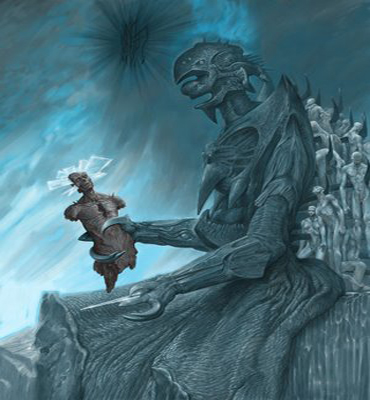|

|
Abaddon (Abbaton, meaning "A place of destruction", "The
Destroyer", "Depths of Hell") in the Revelation of St. John, is the king of tormenting locusts
and the angel of the bottomless pit. The exact nature of
Abaddon is debated, but the Hebrew word is related to the triliteral root אבד (ABD),
which in verb form means "to perish."In the Hebrew scriptures, Abaddon comes to mean "place of
destruction," or the realm of the dead, and is associated with Sheol (see, for instance, Job 26:6, Proverbs 15:11, Proverbs 27:20 and Psalm 88:3, among
others).
The Christian scriptures contain the first known
depiction of Abaddon as an individual entity instead of a place. In St.
John's Revelation 9:1-11, Abaddon is
described as the king of the bottomless pit and of a plague of locusts that
resemble war horses with crowned human faces and having women's hair, lions'
teeth, locusts' wings, and the tail of a scorpion.
The text of the Thanksgiving Hymns—which was found in the Dead Sea
Scrolls—tells of "the Sheol of Abaddon" and of the "torrents of Belial [that] burst into Abaddon". The Biblical Antiquities
attributed to Philo mentions Abaddon as a place (sheol, hell), not as a
spirit or demon or angel. In the 3rd century Acts of Thomas, Abaddon is the name of a
demon, or the Devil himself. Abaddon has
also been identified as the angel of death and destruction, demon of the abyss,
and chief of demons of the underworld hierarchy, where he is equated with Samael or Satan. In magic, Abaddon is often identified with the
Destroying Angel of the Apocalypse.
Abaddon is also one of the compartments of Gehenna.
By extension,
it can mean an underworld abode of lost souls, or hell. In some legends, it is identified as a realm where
the damned lie in fire and snow, one of the places in Hell that Moses visited.
In the lore of the Coptic Church,
Abbaton is the name given to the angel of death. He is given
particularly important roles in two sources, a homily entitled The
Enthronment of Abbaton by Timothy of Alexandria, and the Apocalypse
of Bartholomew. In the homily
by Timothy, Abbaton was first named Muriel, and had been given the task
by God of collecting the earth which would be
used in the creation of Adam. Upon
completion of this task, the angel was then named to be guardian. Everybody,
including the angels, demons, and corporeal entities, felt fear of him. Abbaton
engaged in prayer and ultimately obtained the promise that any men who venerated
him during their lifetime stood the chance of being saved. Abbaton is also said
to have a prominent role in the Last Judgement, as the one who will take the
souls to the Valley of Josaphat. He is described
in the Apocalypse of Bartholomew as being present in the Tomb of Jesus at the moment
of his resurrection.
The symbolism of Revelation 9:11 leaves the exact identification of Abaddon
open for interpretation. Some bible scholars believe him to be the
antichrist or Satan.
In the past Jehovah's Witnesses shared the idea that Abaddon was Satan.
Modern Jehovah's
Witnesses take the contrasting view, believing that Abaddon is a name given to
Jesus.
Some theologians believe Abaddon to be just an angel. Concerning the angel
holding the key to the bottomless pit from Revelation 9 and 20, Gustav Davidson, in
A Dictionary of Angels, Including the Fallen Angels, writes:
- In Revelation 20:2 he "laid hold of the dragon, that old serpent, which
is the Devil, and Satan, and bound him a thousand years". According to the
foregoing, Apollion is a holy (good) angel, servant, and messenger of God; but
in occult and, generally, in noncanonical writings, he is evil
-
-
|
 Copyright(c) 2007
- 2020. All rights reserved. Copyright(c) 2007
- 2020. All rights reserved.
|

![]() Copyright(c) 2007
- 2020. All rights reserved.
Copyright(c) 2007
- 2020. All rights reserved.